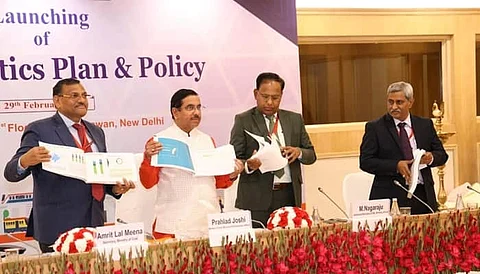

New Delhi: The government plans to increase the share of Railways in coal transportation from 65 percent at present to 87 percent by 2030, said Minister for Coal Pralhad Joshi on Thursday. Releasing the national Coal Logistics Plan and Policy, Joshi said, “With the energy demand set to soar, coal consumption is projected to rise from 980 MT to 1.5 BT by 2030, necessitating efficient logistics. My ministry aims to boost the railways’ share in coal transportation to over 87 percent by 2029-30.”
“We need to continuously expand coal mining and scale up the evacuation infrastructure,” said the minister. The Coal Logistics Plan proposes a shift towards increasing transportation of coal through railways through first mile connectivity (FMC) projects, aiming for a 14 percent reduction in rail logistic costs and an annual cost saving of Rs 21,000 crore. “This transformative approach is expected to minimise air pollution, alleviate traffic congestion, and reduce carbon emissions by approximately 100,000 tonnes per annum. Moreover, a 10 percent saving in average turnaround time of wagons nationwide is expected,” Joshi said.
Along with Railways, Joshi stated that the Coal Ministry is aiming to integrate Rail-Sea-Rail (RSR) transportation, which he said has witnessed a remarkable growth of around 50 percent over the past five years, with plans for further expansion to 120 MT by FY 2030. Across India’s major coal producing triangle of Odisha-Chhattisgarh-Jharkhand, the government is executing a total of eight railway projects that are being funded by coal companies. Currently, four of these projects have been commissioned and one project (Tori-Shivpur) will soon be inaugurated. Besides, coal companies have taken up a total of 103 FMC projects of 1051 MT capacity, incurring a cost of Rs 24000 crore. Out of this, 31 FMCs of 291 MT have been completed till now.
In his keynote address, Coal Secretary Amrit Lal Meena reiterated the Coal Ministry’s commitment to enhancing efficiency in coal transportation and fostering robust infrastructure development. Meena also highlighted proposals for extensive energy corridor projects, including construction of new railway lines and capacity augmentation of existing lines. He stressed on the importance of maintaining momentum to ensure coal’s integral role in India’s energy security and economic growth while upholding sustainability and social responsibility standards and urged all the stakeholders to work in close coordination to ensure easy access to coal to everyone.
“The integrated coal logistics plan contains Indian coal demand and supply scenario, state-wise and coalfield-wise analysis of coal logistics, gaps in coal logistics infra till FY 2046-47 and smart coal technologies. The aim is to identify, evaluate and minimise logistic gaps and infrastructure gaps and achieve efficiency. The broad objective is to ensure adequate coal loading and evacuation infrastructure, promote inter-connection, multi-modal network,” said Additional Coal Secretary M Nagaraju while explaining the objectives of the plan and the policy.
“We want to increase the transportation of coal via rail mode because there are many benefits, including cost, efficiency and environmental. We have to completely eliminate road mode which is currently about 28 percent,” he added.
